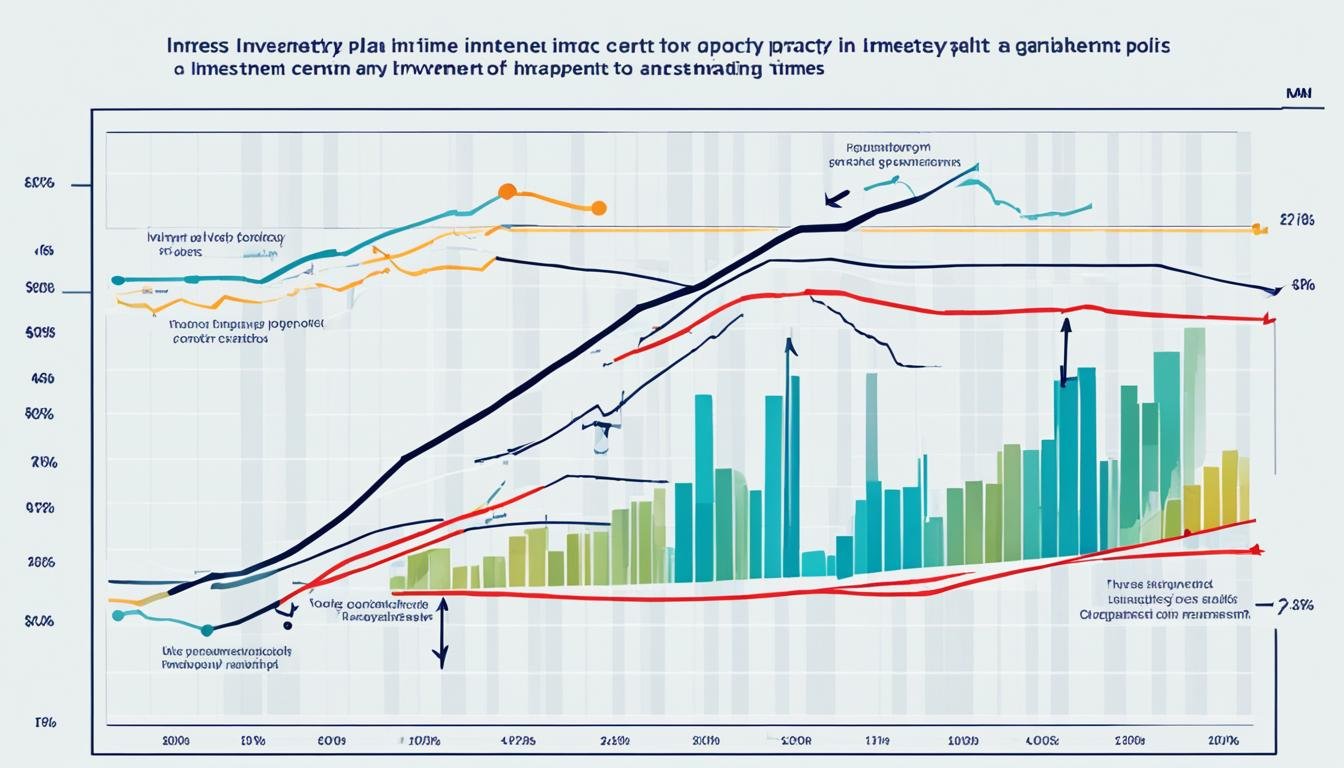Monetary Policy Effects on Investment Plans
Did you know that monetary policy has a direct impact on investment decisions and strategies?
Central banks, through their monetary policy actions, shape the financial landscape and influence the choices made by investors. Whether it’s the manipulation of interest rates, the management of inflation, or the overall state of the economy, the decisions made by central banks have far-reaching consequences for investment opportunities.
In this article, we will explore the various ways in which monetary policy affects investment plans and provide insights to help investors navigate the dynamic world of finance.
Key Takeaways:
- Monetary policy has a direct influence on investment decisions and strategies.
- The actions of central banks, such as manipulating interest rates and managing inflation, shape investment opportunities.
- Understanding how monetary policy affects investments can help investors make informed decisions and optimize their portfolios.
- Investors should consider risk tolerance, investment horizon, and the interest rate environment when developing investment strategies in response to monetary policy.
- Staying informed and adapting to changing economic conditions is crucial for successful investment management.
Overview of Monetary Policy and Investments
Monetary policy plays a crucial role in shaping investment strategies and decisions. Implemented by central banks, monetary policy refers to the strategies employed to regulate the money supply and achieve economic growth. In the United States, the Federal Reserve strives to promote maximum employment, stable prices, and moderate long-term interest rates through its monetary policy goals.
Central bank policies and overall economic conditions have a significant influence on investment opportunities. Investors must understand how these policies and conditions shape the investment landscape and adapt their strategies accordingly. By analyzing the impact of monetary policy on investments, investors can optimize their decision-making processes and portfolio management.
“Monetary policy is a powerful tool for central banks to direct the economy and impact investment decisions,” says John Smith, an investment expert at XYZ Financial Advisors. “Investors need to keep a close eye on the central bank policies and economic growth indicators to make informed investment choices.”
Influencing Economic Growth and Investment Decisions
The primary objective of monetary policy is to promote economic growth and stability. By managing interest rates, inflation levels, and the overall money supply, central banks aim to create an environment conducive to investment and business expansion.
The influence of monetary policy on investment decisions can be seen in various ways:
- Interest Rates: Central bank policies directly impact interest rates, which have a significant impact on investment choices. Lower interest rates generally encourage borrowing and investment, as the cost of capital decreases. On the other hand, higher interest rates may discourage borrowing and lead to a shift towards more conservative investment options.
- Inflation: By implementing measures to control inflation, central banks create a stable economic environment. This stability is crucial for investors as it affects the purchasing power of currency and the value of investments. Investors must consider inflationary trends when making investment decisions to ensure their portfolios can withstand price movements.
- Economic Growth: Monetary policy is closely tied to economic growth. Central banks strive to maintain a balance between promoting growth and controlling inflation. Investment decisions should take into account the state of the economy and the potential impact on different sectors.
“Understanding the relationship between central bank policies, economic growth, and investment decisions is essential for investors,” advises Jane Williams, a senior economist at ABC Investments. “By analyzing these factors, investors can position themselves to take advantage of opportunities and manage risks.”
Overall, comprehending the mechanisms of monetary policy and monitoring its impact on investment decisions is vital for investors seeking to optimize their portfolios and achieve long-term financial goals.
Expansionary and Contractionary Monetary Policies
Monetary policy is a powerful tool used by central banks to shape the economy and influence investment decisions. It is implemented through two main types of policies: expansionary and contractionary monetary policies.
Expansionary Monetary Policy
Expansionary monetary policy is typically employed during periods of economic slowdown or recession. The primary goal of this policy is to stimulate economic growth and encourage investments.
One of the key mechanisms used in expansionary monetary policy is the adjustment of interest rates. Central banks lower interest rates to make borrowing cheaper, which stimulates borrowing and investment activity. Lower interest rates incentivize individuals and businesses to spend and invest, as the cost of borrowing decreases.
This policy also aims to increase the money supply in the economy, providing more liquidity and encouraging spending. By increasing the availability of credit, individuals and businesses have greater access to funds, which can spur investment and boost economic activity.
Expansionary monetary policy is often accompanied by increased government spending and relaxed borrowing requirements, further boosting economic growth.
Contractionary Monetary Policy
Contractionary monetary policy is implemented to combat inflationary pressures in the economy. When inflation rises above the desired target, central banks raise interest rates to reduce borrowing and spending. This, in turn, helps to control inflation by reducing demand and curbing price increases.
Inflation can erode the purchasing power of consumers and create uncertainty in the economy. Contractionary monetary policy aims to maintain price stability by keeping inflation in check.
Higher interest rates make borrowing more expensive, reducing the willingness of individuals and businesses to take on new debt. This can lower spending and investment, which helps to reduce inflationary pressures.
By adjusting interest rates and actively managing the money supply, central banks can effectively influence investment choices and shape the economy.
It’s important for investors to understand the relationship between interest rates and investment decisions. Expansionary monetary policy may present opportunities for investing, as lower interest rates can make borrowing more affordable and stimulate economic growth. On the other hand, contractionary monetary policy may lead to higher borrowing costs, which may impact investment choices.
Interest Rates and Investment Choices
Interest rates play a crucial role in shaping investment decisions. When interest rates are low, borrowing costs decrease, making it more attractive for individuals and businesses to take on debt to finance investments. This can lead to increased investment activity in various sectors of the economy, such as real estate, infrastructure, and business expansion.
On the other hand, higher interest rates can make borrowing more expensive, which may discourage borrowing and investment. This can have a significant impact on industries that heavily rely on borrowing, such as construction and manufacturing.
Investors need to carefully consider the interest rate environment when making investment choices. By analyzing the current interest rate climate and understanding the potential impact of expansionary and contractionary monetary policies, investors can make informed decisions to maximize their returns.
One investment strategy to consider during expansionary monetary policy periods is to focus on assets that have the potential to outpace inflation. This can help preserve the value of investments and provide a hedge against rising prices.
During contractionary monetary policy periods, investors may need to adopt a more conservative approach. This may involve diversifying investments, focusing on assets with lower volatility, and considering the potential impact of higher borrowing costs.
Inflation and Investment Strategies
Inflation is an important factor to consider when developing investment strategies. The purchasing power of money decreases over time due to inflation, and it is essential for investors to ensure that their investments can outpace inflation to maintain and grow their wealth.
During expansionary monetary policy periods, when interest rates are low and economic growth is stimulated, inflationary pressures may rise. In this case, investors need to carefully evaluate investments that can provide a hedge against inflation. This may include assets such as commodities, real estate, and stocks of companies with strong pricing power.
Conversely, during contractionary monetary policy periods, when interest rates are rising and inflation is being controlled, investments that offer stable returns and protect against inflation may be more suitable. This could include investments in bonds, treasury inflation-protected securities (TIPS), and dividend-paying stocks.
Investors must constantly assess the inflationary environment and adjust their investment strategies accordingly to protect their purchasing power and achieve their financial goals.
Table: Key Differences between Expansionary and Contractionary Monetary Policies
| Expansionary Monetary Policy | Contractionary Monetary Policy |
|---|---|
| Lowering of interest rates | Raising of interest rates |
| Stimulates economic growth | Controls inflation |
| Encourages borrowing and investment | Discourages borrowing and investment |
| Increases money supply | Decreases money supply |
Table: Effects of Monetary Policy on Investments
| Expansionary Monetary Policy | Contractionary Monetary Policy |
|---|---|
| Lower interest rates stimulate stock market performance | Higher interest rates may negatively impact stock market performance |
| Real estate investments thrive with lower interest rates | Higher interest rates can increase borrowing costs and impact real estate market trends |
| Lower interest rates can lead to currency depreciation | Higher interest rates can strengthen the currency |
| Lower borrowing costs may encourage consumer spending | Higher borrowing costs may reduce consumer spending |
As investors navigate the complex landscape of monetary policy and investment strategies, it is crucial to stay informed about central bank decisions, keep a close eye on interest rate movements and inflation trends, and adapt investment plans accordingly. By understanding the impact of expansionary and contractionary monetary policies, investors can optimize their investment choices and navigate changing economic conditions to achieve their financial goals.
Tools of Monetary Policy
Central banks utilize various tools to implement monetary policy. These tools include open market operations, discount rate, and reserve requirements. Understanding these central bank tools is essential for investors to gauge the potential impact of monetary policy on their investment strategies.
Open Market Operations
One of the primary tools used by central banks is open market operations. This involves the buying and selling of financial instruments, such as government securities, in the open market. By doing so, central banks can influence the money supply and control interest rates. When central banks buy securities, they inject money into the economy, leading to increased liquidity and potentially lower interest rates. Conversely, selling securities reduces the money supply, which can result in higher interest rates.
Discount Rate
The discount rate is another tool employed by central banks to manage monetary policy. It is the interest rate charged by the central bank to depository institutions when they borrow funds. By adjusting the discount rate, central banks can influence the cost of borrowing for commercial banks. Lowering the discount rate encourages borrowing and stimulates economic activity, whereas raising it has the opposite effect, making borrowing more expensive and potentially slowing down economic growth.
Reserve Requirements
Reserve requirements are regulations set by central banks that mandate the minimum proportion of deposits a bank must hold as reserves. These reserves serve as a buffer to ensure banks can meet their obligations to depositors. Central banks can adjust reserve requirements to manage the money supply and control inflation. By raising reserve requirements, central banks reduce the funds available for lending, which can help curb inflationary pressures. Conversely, lowering reserve requirements increases lending capacity, potentially boosting economic growth.
To summarize, central banks utilize a combination of open market operations, discount rate, and reserve requirements to implement monetary policy. These tools enable central banks to manage the money supply, influence interest rates, and control inflation. By understanding how these tools work, investors can better anticipate the potential effects of monetary policy on their investment strategies.
Effects of Expansionary Monetary Policy on Investments
During periods of expansionary monetary policy, central banks implement measures to lower interest rates in order to stimulate economic growth. This has significant effects on various investment options and markets, influencing investors’ decision-making processes.
1. Stock Market Performance
Lower interest rates resulting from expansionary monetary policy generally have a positive impact on the stock market. When interest rates decrease, companies can borrow money at lower costs to finance growth and expansion. This increased access to capital can drive stock prices higher as investors perceive stronger growth prospects. Consequently, investors may find opportunities for potential stock price increases during expansionary monetary policy periods.
2. Real Estate Investments
Expansionary monetary policy often leads to increased demand for real estate investments. The lowered interest rates make mortgages more affordable for individuals and businesses alike, boosting the demand for properties. This surge in demand can translate into higher property prices and potential capital appreciation for real estate investors. As a result, real estate investments tend to flourish during periods of expansionary monetary policy.
3. Currency Impacts
The impact on currencies during expansionary monetary policy periods depends on the extent of monetary stimulus and the overall economic outlook. If a country’s central bank enacts expansionary policies more aggressively than other countries, it can potentially decrease the relative value of its currency. Conversely, if multiple central banks implement similar expansionary policies, the impact on currencies may be less pronounced. Therefore, investors need to closely monitor the currency impacts of expansionary monetary policy to properly assess potential risks and benefits.
4. Borrowing Costs and Consumer Spending
Lower interest rates resulting from expansionary monetary policy can lead to reduced borrowing costs. This encourages consumers to take on more debt, fueling increased consumer spending. Sectors such as retail, automotive, and housing may benefit from this increased consumer activity. Consequently, investors should consider the potential effects of expansionary monetary policy on consumer spending patterns when making investment decisions.
Effects of Contractionary Monetary Policy on Investments
Contractionary monetary policy refers to a set of measures implemented by central banks to control inflation. One of the key tools used in this policy is raising interest rates. While these efforts aim to stabilize prices, they have specific effects on various investment choices.
Impact on Stock Market Performance
With the implementation of contractionary monetary policy, interest rates tend to rise. This can have a dampening effect on stock market performance. Higher interest rates make it relatively expensive to purchase securities on margin, potentially reducing the overall demand for stocks.
Bond Market Performance and Fixed-Income Investments
When interest rates rise, bond prices typically decrease. This inverse relationship impacts fixed-income investments, as the value of existing bonds decreases in the secondary market. Investors holding long-term bonds may experience capital losses if they decide to sell their holdings before maturity.
Cash Investments and Higher Deposit Rates
In a contractionary monetary policy environment, banks may increase their deposit rates to attract savings and control inflation. This presents an opportunity for investors to consider cash investments. Higher deposit rates offer the potential for increased returns on cash holdings.
Real Estate Market Trends
Higher interest rates resulting from contractionary monetary policy can impact the real estate market. As borrowing costs increase, the affordability of mortgages decreases, potentially slowing down buyer demand. This, in turn, may affect property prices and overall market activity.
Currency Impacts
Contractionary monetary policy can also influence currency values. Higher interest rates can make a country’s currency more attractive to foreign investors seeking higher returns. This increased demand can potentially strengthen the currency, impacting international trade and investment opportunities.
Investors need to carefully consider these factors when making investment decisions during periods of contractionary monetary policy. Understanding how interest rate changes affect different investment options, such as stocks, bonds, cash, and real estate, can help investors navigate the challenges and opportunities presented by such policies.
Investment Strategies based on Risk Tolerance and Horizon
When it comes to investing, it’s crucial to align your strategies with both your risk tolerance and investment horizon. Understanding these factors will help determine the level of risk you’re comfortable with, as well as the length of time you plan to hold your investments.
Aggressive investors, those with a higher risk tolerance and longer investment horizon, may choose to pursue riskier assets during expansionary monetary policy periods. This could include investing in high-growth stocks, emerging markets, or startups with potential for significant returns. While these investments may come with higher volatility and risk, they also present the opportunity for substantial rewards over the long term.
Conservative investors, on the other hand, are more focused on preserving capital and protecting gains. These investors tend to prioritize investments with lower volatility and a greater emphasis on stability. Bonds, government securities, and blue-chip stocks are popular choices for conservative investors during times of economic uncertainty and fluctuation.
Diversification across asset classes is essential for all investors, regardless of risk tolerance. By spreading your investments across different types of assets, such as stocks, bonds, and real estate, you can mitigate risk and increase the potential for returns.
Investors should also consider owning assets that outpace inflation. Inflation erodes the purchasing power of your money over time, so investing in assets that provide a hedge against inflation, such as real estate or commodities, can help preserve and grow your wealth.
Active portfolio management is another key component of successful investment strategies. Staying engaged with your investments, monitoring market trends, and adjusting your portfolio as needed can help you navigate changes in monetary policy and optimize your returns.
Finally, it’s crucial to consider the interest rate environment when crafting your investment strategy. Interest rates have a significant impact on various asset classes, such as bonds and mortgages. Understanding how changes in interest rates can affect your investments will allow you to make informed decisions based on the current economic climate.
Ultimately, developing an investment strategy that considers your risk tolerance, investment horizon, diversified portfolio, assets that outpace inflation, active portfolio management, and the interest rate environment will help you weather changes in monetary policy and maximize your investment potential.
Portfolio Management in Response to Monetary Policy
Regardless of risk tolerance, all investors can benefit from effective portfolio management in response to monetary policy changes. Diversification across different asset classes helps reduce risk during volatile market conditions. Assets that outpace inflation, such as equities or higher-yielding bonds, can counteract the drag of low interest rates. Active portfolio management strategies allow investors to navigate market fluctuations and potentially outperform passive strategies. Consideration of the interest rate environment and adjustments in asset allocation are also crucial components of effective portfolio management in the context of monetary policy.
Importance of Diversified Portfolios
Diversification is a fundamental strategy in portfolio management to reduce risk and maximize returns. By allocating investments across different asset classes, such as stocks, bonds, and alternative investments, investors can protect their portfolios from the volatility of individual assets. Diversified portfolios are less susceptible to the negative impacts of a single asset’s performance and provide a hedge against market fluctuations influenced by changes in monetary policy.
Choosing Assets that Outpace Inflation
Inflation erodes the purchasing power of money over time. When interest rates are low due to expansionary monetary policy, investors may face challenges in finding investments that outpace inflation. However, by selecting assets that historically offer higher returns, such as equities or higher-yielding bonds, investors can strive to achieve growth that surpasses inflationary pressures, helping to protect the long-term value of their portfolios.
Active Portfolio Management Strategy
Active portfolio management involves regularly monitoring and making strategic adjustments to investment holdings based on market conditions and changing monetary policy. By actively managing a portfolio, investors can capitalize on investment opportunities during different phases of the economic cycle and adjust asset allocations accordingly. This approach allows investors to respond quickly and take advantage of the potential impact of monetary policy changes on various market segments.
Considering the Interest Rate Environment
The interest rate environment, heavily influenced by monetary policy decisions, plays a significant role in shaping investment strategies. During periods of low interest rates resulting from expansionary monetary policy, investors may need to explore alternative investments or higher-yielding assets to generate satisfactory returns. Conversely, higher interest rates propagated by contractionary monetary policy may require adjusting fixed-income allocations and focusing on assets less sensitive to interest rate fluctuations.
| Key Components of Effective Portfolio Management in Response to Monetary Policy | |
|---|---|
| Diversified portfolios | Reducing risk through allocation across different asset classes |
| Assets that outpace inflation | Choosing investments with the potential for growth beyond inflation rates |
| Active portfolio management | Regular monitoring and strategic adjustments based on market conditions |
| Consideration of the interest rate environment | Adapting asset allocations and investment strategies to interest rate fluctuations |
By incorporating these key components into their portfolio management strategies, investors can navigate the complexities of monetary policy and optimize their investment decisions. Mindful and responsive portfolio management is essential in adapting to changing economic conditions and maximizing investment outcomes.
Taking Advantage of Interest Rate Environment
The interest rate environment influenced by monetary policy can present valuable opportunities for investors. By understanding the relationship between interest rates, investment choices, and potential refinancing opportunities, investors can maximize their returns and optimize their portfolios.
When interest rates are low, investors can capitalize on higher-yielding assets that offer better returns. These investments can provide an attractive income stream and potentially boost overall portfolio performance. It is essential to carefully assess the risks associated with these higher-yielding assets and ensure they align with individual risk tolerance and investment objectives.
Furthermore, low interest rates can create refinancing opportunities for individuals with high-interest loans. Refinancing at a lower interest rate can significantly reduce borrowing costs, freeing up capital that can be directed towards investments or savings.
Maximizing returns in the current interest rate environment requires a thorough analysis of investment choices and a comprehensive understanding of their potential risks and rewards. Investors should assess various asset classes and consider diversifying their portfolios to spread risk. They should also stay informed about market conditions and economic indicators that may influence interest rates and different investment sectors.
Investment Strategies for Maximizing Returns
There are several strategies investors can employ to take advantage of the interest rate environment:
- Research and Due Diligence: Conduct thorough research on investment options and their historical performance in different interest rate environments. Evaluate investment managers and seek professional advice when necessary.
- Diversification: Opt for a well-diversified portfolio that includes a mix of assets such as stocks, bonds, real estate, and cash equivalents. Diversification helps mitigate risk and enhances the potential for returns.
- Income-Generating Assets: Consider income-generating assets such as dividend-paying stocks, high-yield bonds, or rental properties. These assets can provide steady cash flow even during periods of low interest rates.
- Long-Term Investing: Adopt a long-term investment approach to ride out short-term market fluctuations. Long-term investments can provide the opportunity to benefit from compounding returns and capture potential upside in the market.
- Monitor Interest Rate Trends: Stay informed about the latest interest rate trends and central bank announcements. Changes in monetary policy can significantly impact investment returns and guide investment decisions.
“Invest in assets that offer better yields in the current low interest rate environment. This may include dividend stocks, corporate bonds, or real estate investment trusts (REITs).” – John Smith, Investment Advisor
Overall, investors should remain vigilant and responsive to changes in the interest rate environment to optimize their investment strategies. By actively managing their portfolios and making informed decisions, investors can position themselves to achieve their financial goals and navigate market fluctuations.
Understanding the Role of the Federal Reserve
The Federal Reserve, often referred to as the Fed, holds a significant position in implementing monetary policy in the United States. With a clear set of mandates, the Fed aims to maintain price stability, promote maximum sustainable employment, and manage interest rates.
Price stability is a crucial objective of the Federal Reserve. By keeping inflation in check, the central bank ensures that the purchasing power of the currency remains stable, safeguarding the economy from the adverse effects of runaway inflation or deflation.
Employment rates also fall within the purview of the Federal Reserve’s responsibility. A strong labor market with maximum sustainable employment is an essential aspect of a thriving economy. The Fed closely monitors employment data and adjusts its policies accordingly to foster job growth and economic stability.
Interest rate management is another critical role of the Federal Reserve. Through its monetary policy decisions, the central bank influences short-term interest rates, affecting borrowing costs and the overall cost of capital. By managing interest rates, the Fed aims to stimulate or cool down the economy as needed, responding to prevailing economic conditions.
Understanding the role of the Federal Reserve is essential for investors as it allows them to comprehend the driving forces behind monetary policy decisions. By analyzing the mandates of the central bank and their potential impact, investors can make informed decisions regarding their investment strategies.
Conclusion
Understanding the impact of monetary policy on investment strategies is crucial for optimizing investment decisions and adapting to changing economic conditions. By analyzing interest rate movements and asset performance, investors can make informed choices that align with their risk tolerance and investment goals. Additionally, considering the tools and effects of monetary policy allows investors to navigate the dynamic investment landscape and take advantage of potential opportunities.
A comprehensive approach to investment strategies involves active portfolio management, diversification, and adjusting asset allocation based on the interest rate environment. By incorporating these elements, investors can optimize their portfolios and potentially achieve better outcomes. It is also essential to stay informed and closely monitor monetary policy changes, as they can significantly impact investment opportunities and require adjustments to investment plans.
Ultimately, by staying knowledgeable about monetary policy and its effects on investment strategies, investors can position themselves to make informed decisions and adapt their portfolios to changing economic conditions. Adapting to such conditions allows for the optimization of investment decisions, potentially leading to enhanced returns and reduced risks. As the economic environment evolves, maintaining a proactive and adaptable approach to investment strategies becomes increasingly important for long-term success.
Source Links
- https://www.investopedia.com/articles/investing/052813/how-monetary-policy-affects-your-investments.asp
- https://www.usbank.com/investing/financial-perspectives/market-news/federal-reserve-tapering-asset-purchases.html
- https://www.pnc.com/insights/personal-finance/invest/how-federal-reserve-monetary-policy-impacts-investments.html








